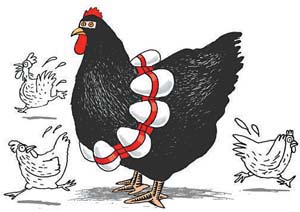 How bird flu affects people
[ 2006-08-02 11:13 ]

禽流感是近几年从动物扩散到人类的一种疾病。随着候鸟的迁徙,每年都有大规模爆发的可能。你也许要问一个小小的病毒怎么会有如此的威力?且看下文分解。
 Viruses are tiny bundles of genetic material that are enclosed in a shell called a viral coat. They exist for one purpose only--- to reproduce or make more viruses. They achieve this goal by putting their genetic material into the host cell. Once in the infected host cell the viral genetic material inserts itself into the host's genetic material, the host is then instructed by the viral genetic material to replicate many times. This allows the virus to make a numerous copies of it. The host cell is also instructed by the viral genetic material to assemble new viruses that grow numerous in numbers causing the host cell to burst or release the new viruses. A virus can only infect and causehavocin one species, and may not have a noticeable effect in another. Viruses are tiny bundles of genetic material that are enclosed in a shell called a viral coat. They exist for one purpose only--- to reproduce or make more viruses. They achieve this goal by putting their genetic material into the host cell. Once in the infected host cell the viral genetic material inserts itself into the host's genetic material, the host is then instructed by the viral genetic material to replicate many times. This allows the virus to make a numerous copies of it. The host cell is also instructed by the viral genetic material to assemble new viruses that grow numerous in numbers causing the host cell to burst or release the new viruses. A virus can only infect and causehavocin one species, and may not have a noticeable effect in another.
Flu viruses are classified into three groups: A, B or C. This classification depends on the different proteins they contain. Type A viruses are found in many different types of animals: ducks, pigs, chicken and humans. Type B viruses are found mainly in humans and type C are found in pigs, dogs and humans too but do not causeepidemics. Type A viruses, which are the most aggressive of all flu viruses, are further divided into groups based on the two surface proteins HA and NA.
The flu virus has existed in wild aquatic birds such as ducks. The virus does not necessarily affect the birds. The virus often mutates (changes it genetic material) and "jumps" across the species barrier to infect domestic poultry and then to pigs and other domestic animals. The pig acts as the "mixing bowl" as the pig can be infected by both human and avian viruses simultaneously. The viruses come in close to each other and exchange genetic material allowing the new virus to spread from pigs to people. This was thought the route that avian or bird flu spread to humans but about ten years ago it was discovered that bird flu skipped the pig step and infected humans directly. This triggered the fear of a pandemic. Fortunately for now, the virus cannot spread effectively from human to human.
Once infected by the bird flu, viruses infect the cells in the human lungs. Normally the virus attacks the cells that are deep in the lungs where the exchange of oxygen and carbon dioxide takes place. The symptoms of a bird flu infection are similar to the regular human flu infection namely fever, cough, muscle fatigue and sore throat. These symptoms may further develop intopneumoniaand acuterespiratoryillness and other life-threatening illnesses.
havoc:混乱,浩劫
epidemics:流行性疾病
pneumonia:肺炎
respiratory:呼吸的
(英语点津 Annabel 编辑)
|